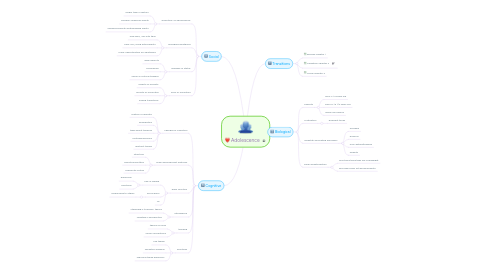
1. Social
1.1. "invention" of adolescence
1.1.1. longer than in history
1.1.2. children viewed as adults
1.1.3. owning property distinguished adults
1.2. emerging adulthood
1.2.1. new idea, I fall into this!
1.2.2. early 20s, living with parents
1.2.3. many opportunities for adulthood
1.3. changes in status
1.3.1. legal aspects
1.3.2. boundaries
1.3.3. social or cultural triggers
1.4. poor or minorities
1.4.1. effects of poverty
1.4.2. effects of minorities
1.4.3. easing transitions
2. Cognitive
2.1. changes in cognition
2.1.1. realtive vs absilute
2.1.2. possibilities
2.1.3. think about thinking
2.1.4. multidemensional
2.1.5. abstract things
2.2. brain development anatomy
2.2.1. structure
2.2.2. neurotransmitters
2.2.3. prefrontal cortex
2.3. brain function
2.3.1. risk vs reward
2.3.1.1. dopamine
2.3.1.2. serotonin
2.3.2. social brain
2.3.2.1. responding to others
2.3.3. IQ
2.4. intelligence
2.4.1. sternberg's "triarchic" theory
2.4.2. vygotsky's perspective
2.5. thinking
2.5.1. theory of mind
2.5.2. social conventions
2.6. emotions
2.6.1. risk taking
2.6.2. sensation seeking
2.6.3. reducing these behaviors
3. Transitions
3.1. Biology chapter 1
3.2. Cognition chapter 2
3.3. Social chapter 3
4. Biological
4.1. Puberty
4.1.1. girls-7-13 years old
4.1.2. boys 9-13 1/2 years old
4.1.3. differs by person
4.2. Maturation
4.2.1. different times
4.3. Obestity and Eating Disorders
4.3.1. anorexia
4.3.2. bulemia
4.3.3. over-eating/binging
4.3.4. obesity
4.4. body dissatisfaction
4.4.1. most girls think they are overweight
4.4.2. girls gain body fat during puberty
